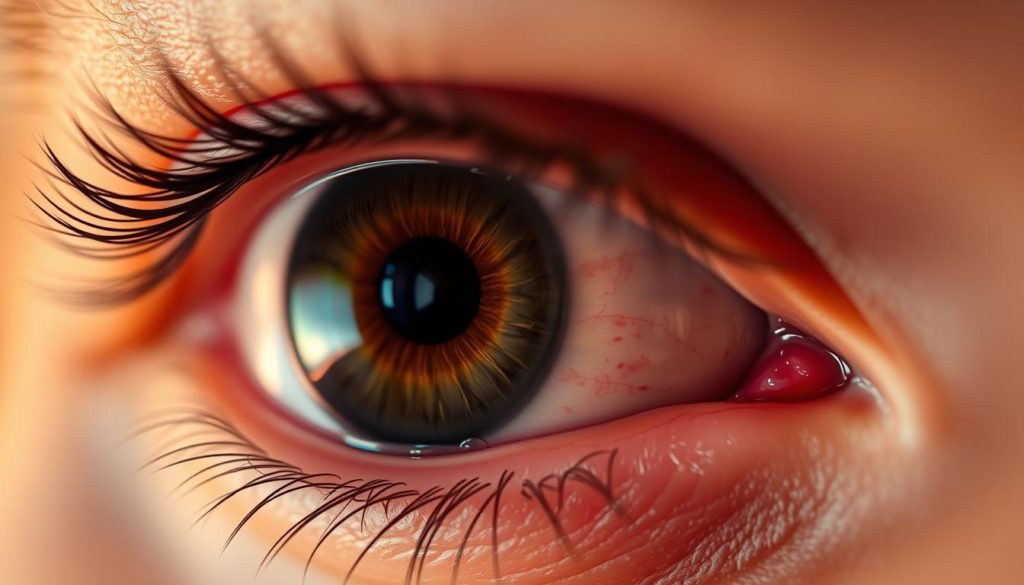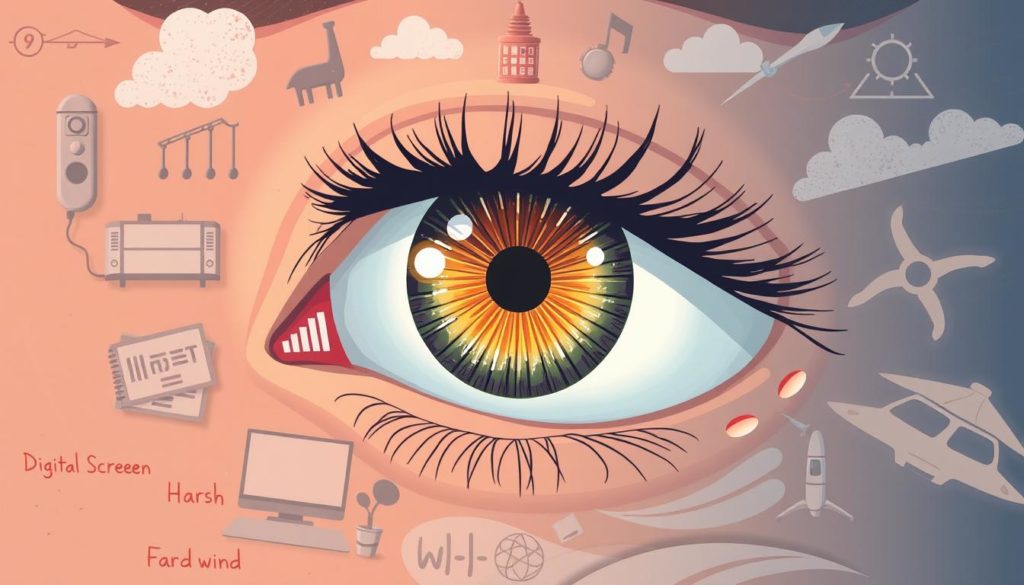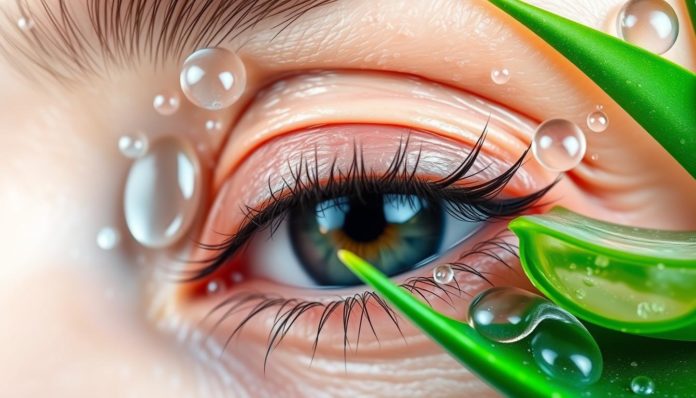Did you know about 16 million Americans have dry eyes? That means almost 1 out of 20 people deal with eye discomfort each day. Our eyes get irritated and scratchy, especially now. More screen time and mask use are making it worse. This article will give you tips to ease dry eye symptoms and keep your eyes healthy.
Jane had bad dry eyes because she used contact lenses a lot and didn’t clean them well. Her eyes were really suffering. She looked for help and found many modern treatments. You can buy some treatments without a prescription or get stronger ones from a doctor. They help make more tears to soothe your eyes.
We’ll show you ways to fight dry eyes and feel better in this article. We’ll talk about easy changes to your daily routine and more complex options if you need them. Get ready to improve your eye comfort and health.
Understanding Dry Eye Symptoms
Dry eyes can affect anyone, caused by various factors. These include the environment, health issues, and certain treatments. People with dry eyes either don’t produce enough tears or have poor-quality tears. It’s key to know how dry eyes can vary to keep your eyes healthy.

Common Symptoms
Dry eye symptoms start with a gritty feeling, like there’s something in your eye. This feeling can come with eye irritation, dryness, or tired eyes. Blurred vision is also common, making it hard to read or use a computer.
Sometimes, eyes react by tearing up a lot to counter the dryness. This might seem odd but happens quite often.
Signs of Severe Dry Eye
In severe cases, dry eyes can be really troubling. You may have ongoing eye irritation, redness, and swelling. Long-term blurred vision can make day-to-day tasks difficult, lowering your quality of life. Severe dry eyes can also hurt, showing the need for urgent and thorough care.
Causes of Worsening Dry Eyes

Dry eyes get worse from many things, like where you live and health problems. Some medicines and treatments can also make it tougher.
Environmental Factors
Places with low humidity, wind, or a lot of pollution can make dry eyes worse. For example, smog or smoke can take away eye moisture, making symptoms stronger. Being in places with lots of air conditioning or heat can also dry your eyes out.
Health Conditions
Some health issues, especially autoimmune diseases, are major causes of dry eyes. Diabetes, rheumatoid arthritis, and Sjögren’s syndrome can reduce tear making or change tear makeup. This can make your tears saltier, leading to eye surface inflammation and feelings of burning or itching.
Medications and Treatments
Certain medicines, like antihistamines and antidepressants, can make dry eyes worse by cutting down on tear making. Treatments such as radiation near the head or neck, and LASIK surgery, can also increase dry eye risks. It’s important to talk to your doctor if you think your medicine is affecting your eyes.
Effective Dry Eye Treatments
Fighting dry eyes begins with picking the right cure. We have everything from easy fixes to more complex therapies. Let’s explore options ranging from store-bought eye drops to specific treatments designed for you.
Over-the-Counter Options
For those with slight dry eye issues, store-bought eye drops can help fast. It’s best to use preservative-free types to avoid irritation. They moisten the eyes, help heal, and make your eyes feel better.
Prescription Therapies
If store-bought drops don’t cut it, prescription treatments might. Drugs like Restasis or Xiidra reduce swelling and make more tears. They tackle the root causes, giving stronger and longer relief.
Punctal Plugs
Punctal plugs are for keeping eyes moist. They stop tears from draining away too fast. This keeps both natural and added tears on your eyes longer, helping with dryness and promoting healing.
New treatments and tailored care in places like the Advanced Dry Eye Specialty Clinic are huge steps forward. These clinics offer customized care, making dry eye treatments more effective than before.
Daily Habits for Dry Eye Relief
Creating a daily routine can really help with dry eyes. Simple steps can greatly lessen discomfort and boost eye moisture.
Eye Drops and Artificial Tears
Regular use of eye drops or artificial tears keeps eyes moist. They are very helpful for those in dry places or with AC on a lot. Opt for ones without preservatives to dodge more irritation.
Warm Compresses
Warm compresses bring relief and comfort to dry eyes. They help unclog oil glands, improving oil flow and moisture in the eyes.
Screen Time Management
Limiting screen time is key to avoiding worse dry eye symptoms. Take breaks using the 20-20-20 rule to reduce eye strain. Screen filters and brightness adjustments also help soothe eyes.
| Habit | Benefit |
|---|---|
| Use of Eye Drops | Maintains eye moisture |
| Warm Compresses | Relieves discomfort |
| Screen Time Management | Prevents symptom exacerbation |
Home Remedies for Alleviating Dry Eyes
Alleviating dry eyes can start with simple changes at home. Making certain lifestyle changes can really help your eye comfort and health. Try dietary adjustments and improving indoor air quality for the best results.
Dietary Adjustments
One effective way to help dry eyes is by changing your diet. Add foods high in omega-3 fatty acids like salmon, flaxseeds, and walnuts. These help with tear production and reduce inflammation.
Also, eat more vitamins A, C, and E. They work as antioxidants, keeping your eyes from harm and supporting their health. Remember to drink plenty of water. Staying hydrated is key to keeping your eyes moist.
Humidifiers and Air Quality
Improving your home’s air quality is another vital step. A humidifier adds moisture to the air, which helps your eyes stay less dry. This is especially helpful in winter when heating can dry out the air indoors.
Avoid air pollutants and irritants as much as possible. Use air purifiers and ensure good ventilation to keep the air fresh. Doing this makes a big difference in dealing with dry eyes.
Using these dry eye home remedies offers a comprehensive approach. Here’s a closer look at the environmental changes and their benefits:
| Remedy | Benefits |
|---|---|
| Humidifiers | Increases indoor air moisture, reducing dryness. |
| Air Purifiers | Removes irritants and pollutants, enhancing air quality. |
| Ventilation | Prevents stagnation of indoor air, ensuring fresher air circulation. |
Understanding Chronic Dry Eye
Chronic dry eye significantly impacts one’s ocular surface health and life quality. It’s more than an annoyance. It brings discomfort, much like physical injuries. Sufferers often deal with irritation, redness, and blurred vision. These issues make daily tasks hard.
To keep good ocular surface health, managing chronic dry eye is key. Use artificial tears and take screen breaks. Also, see a professional when needed. Early action can stop worse problems and boost life quality.
- *Reading*
- *Driving*
- *Working on a computer*
- *Outdoor activities*
Good management eases symptoms and improves life quality. Regular eye care visits offer custom advice for chronic dry eye. By being proactive, patients safeguard their ocular surface health. And they enjoy a better life.
Recognizing and Managing Dry Eye Flare-ups
Having a sudden dry eye flare-up is more than just uncomfortable. It feels like your eyes are having an asthma attack. Knowing what triggers these flare-ups and how to avoid them is key. This knowledge helps keep your eyes healthy.
Common Triggers
Dry eye flare-ups can be sparked by several factors. Air conditioning, lots of screen time, and bad-fitting face masks worsen symptoms. Knowing these triggers helps you dodge the worst of it.
Preventative Measures
Daily eye care can prevent dry eye flare-ups. Use humidifiers in dry places and take breaks from screens. Pre-treating eyes before surgeries also helps prevent flare-ups.
- Use humidifiers in dry spaces.
- Take frequent breaks from screen usage.
- Ensure proper fit for face masks.
Emergency Relief Tips
Sometimes, you need fast relief from a dry eye flare-up. Using eye drops like Systane or getting prescription treatments such as Eyesuvis helps. Cold compresses also offer fast soothing.
| Emergency Relief Methods | Description |
|---|---|
| Lubricating Eye Drops | Systane or similar products |
| Prescription Therapies | Eyesuvis or similar medications |
| Cold Compresses | Provides an instant soothing effect |
How Contact Lenses Impact Dry Eyes
Contact lenses can affect dry eyes, changing how comfortable you feel. It’s important to choose the right kind of lenses. Also, good lens care and looking into other options can really help.
Choosing the Right Lenses
Contacts made for dry eyes can offer a lot of relief. Choosing daily disposables helps avoid buildup that bothers dry eyes. Materials like silicone hydrogel let more oxygen through, keeping eyes moist.
Proper Lens Care
Keeping lenses clean is key to fighting off dry eye symptoms. This means cleaning, storing them right, using the correct solutions, and not wearing them too long. Overwearing them can make dryness worse.
Alternatives to Contact Lenses
If dry eyes still bother you, even with the right contacts and care, you might need to try something else. Wearing glasses more often or considering eye surgery could help. Scleral lenses are another good choice for dry eyes, as they cover the cornea well.
When to Seek Professional Help for Dry Eyes
If you’re dealing with constant dry eye symptoms, it’s probably time to see an eye doctor. Don’t ignore signs like severe discomfort, lots of redness, or overly watery eyes. These symptoms mean you should get an ophthalmologist consultation quickly.
For extreme cases, or if you suspect something like Sjögren’s syndrome, seeing a dry eye specialist is key. They can diagnose you properly and create a treatment plan. Catching these issues early helps avoid more damage and gets you relief faster.
Here are signs you need professional eye care:
- Daily dryness even after using over-the-counter products
- Constant itching or burning feeling
- Being really sensitive to light
- Ongoing blurry vision or eye tiredness
- Big changes in how much you tear up
Seeing an ophthalmologist is crucial to getting a custom treatment plan. They offer care that specifically addresses your eye health issues.
The perks of getting a professional eye care check-up include:
| Evaluation Type | Advantages |
|---|---|
| Initial Consultation | Finds the main reason for your dry eye problem |
| Specialist Referral | Gives you access to personalized treatments and high-level care |
| Follow-Up Visits | Helps track how well the treatment works and makes changes if necessary |
Knowing when to seek expert advice can greatly help in controlling dry eyes. It also boosts your eye comfort. Regular visits to an ophthalmologist ensure serious issues are taken care of right away.
Long-term Strategies for Dry Eye Relief
Managing dry eyes for a long time needs a careful and steady plan. Here are some important strategies to help your eyes stay healthy.
Regular Eye Exams
Long-term dry eye management starts with regular eye exams. Seeing an eye doctor often can spot changes early. This means your treatment can be adjusted quickly.
Regular check-ups help avoid bigger issues by catching problems early. This keeps any new issues from getting worse.
Personalized Treatment Plans
Your eye health is unique, so you need a personalized eye care plan. Depending on your situation, your eye doctor might recommend different treatments. These could include special eye drops, punctal plugs, or other procedures.
You can find out more about these personalized options by clicking this link.
Integrating Lifestyle Changes
Making lifestyle changes is key for managing dry eyes long-term. Add Omega-3 fatty acids to your diet and use a humidifier to keep the air moist. Also, take breaks when using screens to help prevent eye strain.
Drinking enough water and avoiding smoke and allergens also help. By doing these things regularly, managing dry eyes becomes much easier.
Worsening Dry Eyes: Advanced Treatment Options
For those dealing with severe dry eyes, regular treatments might not be enough. Luckily, there are advanced options available that focus on improving corneal health and overall eye comfort. These include cutting-edge drug therapies and surgeries aimed at fixing and revitalizing the eye’s surface.
Ocular surface reconstruction is a key advancement in this area. It involves techniques like amniotic membrane transplants to fix major damage and help new, healthy tissue grow. Addressing the root causes of severe dry eyes with these methods can greatly enhance comfort and sight.
It’s also important to keep up with new developments in eye care. The sector is changing fast, with fresh medications and unique treatment plans popping up. By getting involved in clinical trials or talking to an eye specialist, people can find relief and improve their life quality. Keeping the cornea healthy is essential for anyone with ongoing dry eye issues.
FAQ
What are the common symptoms of dry eye?
Dry eye symptoms include feeling like there is grit in the eyes and blurry vision. You might also feel a burning sensation or have a lot of tears. Your eyes can feel very tired too.
What causes worsening dry eyes?
Environmental factors like dry air can make dry eyes worse. Health issues such as diabetes, rheumatoid arthritis, or Sjögren’s syndrome contribute too. Certain medications may also increase dryness.
How can I manage dry eye symptoms daily?
To handle dry eye daily, use artificial tears without preservatives. Apply warm compresses to your eyes. Limit screen time and care for your contact lenses well.
Are there home remedies for alleviating dry eyes?
Yes, for dry eyes, eating foods that help make tears is good. Use humidifiers to keep air moist. Also, taking screen breaks helps your eyes relax.
What are the options for over-the-counter dry eye treatments?
For dry eyes, you can use artificial tears that don’t have preservatives. There are also lubricating drops and gel ointments. These help keep eyes moist.
When should I consult a professional for dry eye treatment?
See an eye doctor if dry eye symptoms get really bad or keep getting worse. Also, go if you think you have a condition like Sjögren’s syndrome.
How do contact lenses impact dry eyes?
Contact lenses might make dry eyes feel worse if not used right. Choosing daily disposable lenses and materials that help keep eyes wet may help.
What are the advanced treatment options for severe dry eyes?
For serious dry eyes, there are treatments like prescription medicine and punctal plugs. Also, new drug therapies and maybe surgery for severe eye damage.
What are dry eye flare-ups and how can I manage them?
Flare-ups are sudden worsenings of dry eye symptoms caused by things like air conditioning and long screen time. Using preventive measures and special eye treatments like Eyesuvis can help.
What are long-term strategies for dry eye relief?
Long-term dry eye relief includes getting regular eye check-ups and following a treatment plan. Make lifestyle changes like eating well and minimizing screen time for healthier eyes.


